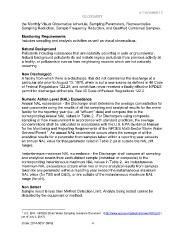Page 163 - California Stormwater Workshop Handouts
P. 163
ATTACHMENT C
GLOSSARY
the Monthly Visual Observation schedule, Sampling Parameters, Representative
Sampling Reduction, Sample Frequency Reduction, and Qualified Combined Samples.
Monitoring Requirements
Includes sampling and analysis activities as well as visual observations.
Natural Background
Pollutants including substances that are naturally occurring in soils or groundwater.
Natural background pollutants do not include legacy pollutants from previous activity at
a facility, or pollutants in run-on from neighboring sources which are not naturally
occurring.
New Discharge(r)
A facility from which there is a discharge, that did not commence the discharge at a
particular site prior to August 13, 1979, which is not a new source as defined in 40 Code
of Federal Regulations 122.29, and which has never received a finally effective NPDES
permit for discharges at that site. See 40 Code of Federal Regulations 122.2.
Numeric Action Level (NAL) Exceedance
Annual NAL exceedance - the Discharger shall determine the average concentration for
each parameter using the results of all the sampling and analytical results for the entire
facility for the reporting year (i.e., all "effluent" data) and compare this to the
corresponding Annual NAL values in Table 2. For Dischargers using composite
sampling or flow measurement in accordance with standard practices, the average
concentrations shall be calculated in accordance with the U.S. EPA Guidance Manual
for the Monitoring and Reporting Requirements of the NPDES Multi-Sector Storm Water
General Permit.1 An annual NAL exceedance occurs when the average of all the
analytical results for a parameter from samples taken within a reporting year exceeds
an annual NAL value for that parameter listed in Table 2 (or is outside the NAL pH
range);
Instantaneous maximum NAL exceedance - the Discharger shall compare all sampling
and analytical results from each distinct sample (individual or composite) to the
corresponding Instantaneous maximum NAL values in Table 2. An instantaneous
maximum NAL exceedance occurs when two or more analytical results from samples
taken for any parameter within a reporting year exceed the instantaneous maximum
NAL value (for TSS and O&G), or are outside of the instantaneous maximum NAL
range (for pH).
Non Detect
Sample result is less than Method Detection Limit; Analyte being tested cannot be
detected by the equipment or method.
1 U.S. EPA. NPDES Storm Water Sampling Guidance Document. <http://www.epa.gov/npdes/pubs/owm0093.pdf >.
[as of July 3, 2013]
Order 2014-0057-DWQ 4

